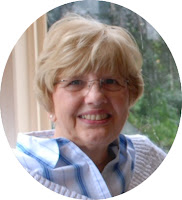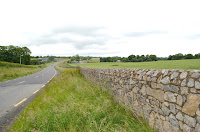Irish Roads
We were in Ireland, my husband
and I, and I saw this stretch of empty road ahead of us, so I pounded on his
shoulder and said, “Do take a picture here, please!” And because he is a most
obliging man he didn’t even sigh. He pulled over to the side of the road and
took this picture.
and I, and I saw this stretch of empty road ahead of us, so I pounded on his
shoulder and said, “Do take a picture here, please!” And because he is a most
obliging man he didn’t even sigh. He pulled over to the side of the road and
took this picture.
I was working then on a book
about an Irish rebel named Diarmaid MacGuinness. He and a young Donegal girl
he’d taken along with him (mostly because he didn’t like leaving her in danger
at the hands of her drunken father) had to get from the Inishowen peninsula in
Donegal—which is as far north and west as you can get in Ireland—to Galway,
where the rebel group he was planning conspiracies with were centered. It was a
long distance, close to 300 miles, and this was 200 years ago, at the beginning
of the 19th century.
about an Irish rebel named Diarmaid MacGuinness. He and a young Donegal girl
he’d taken along with him (mostly because he didn’t like leaving her in danger
at the hands of her drunken father) had to get from the Inishowen peninsula in
Donegal—which is as far north and west as you can get in Ireland—to Galway,
where the rebel group he was planning conspiracies with were centered. It was a
long distance, close to 300 miles, and this was 200 years ago, at the beginning
of the 19th century.
Back then, when you needed to
get somewhere and had little money and no horse or donkey of your own, you
walked. And so my hero, Diarmaid, and this young girl, Muirne, set out to walk
to Galway.
That was easy enough to decide.
But it has filled my mind ever since, thinking of those Irish roads they walked
along. They would not have been empty roads, like the one my husband
photographed. Nor, I imagine, would it be what we visualize as rush hour
traffic. But there would always be somebody in view. Somebody ahead of them,
somebody behind. There would be carts, and a farmer leading a cow from one
place to another. There might be an occasional carriage—not a great many of
them, most likely, because Donegal then was even more isolated than Donegal now
is. There would be those riding on horseback, probably quite a few of them.
There would be farm carts, and in some of them perhaps children, being given a
ride by their father or grandfather from one place to another.
But it has filled my mind ever since, thinking of those Irish roads they walked
along. They would not have been empty roads, like the one my husband
photographed. Nor, I imagine, would it be what we visualize as rush hour
traffic. But there would always be somebody in view. Somebody ahead of them,
somebody behind. There would be carts, and a farmer leading a cow from one
place to another. There might be an occasional carriage—not a great many of
them, most likely, because Donegal then was even more isolated than Donegal now
is. There would be those riding on horseback, probably quite a few of them.
There would be farm carts, and in some of them perhaps children, being given a
ride by their father or grandfather from one place to another.
Mostly there would be others
walking. Some would be going short distances—or what they thought of as short.
A few, like Diarmaid and Muirne, would have longer journeys ahead of them. They
would walk whatever the weather, and in Ireland it rains quite a lot. They
would settle down in any field where they could when nightfall came, since even
if they might encounter an inn they had to save their money, mostly, for the
food they needed to eat, cooked over a small fire. In the morning they would
wake and walk again, joining the others along the roads that linked the towns
and villages and empty spaces of Ireland.
walking. Some would be going short distances—or what they thought of as short.
A few, like Diarmaid and Muirne, would have longer journeys ahead of them. They
would walk whatever the weather, and in Ireland it rains quite a lot. They
would settle down in any field where they could when nightfall came, since even
if they might encounter an inn they had to save their money, mostly, for the
food they needed to eat, cooked over a small fire. In the morning they would
wake and walk again, joining the others along the roads that linked the towns
and villages and empty spaces of Ireland.
I can’t say that I envy them,
or would have wished away the comfortable car we were riding in when we saw
that patch of empty Irish road I wanted to remember. But that road, and those
like it—dirt back then; pavement was a long way in the future—live in my memory
with the people who walked them, one step at a time, because they needed to get
from one place to another.
or would have wished away the comfortable car we were riding in when we saw
that patch of empty Irish road I wanted to remember. But that road, and those
like it—dirt back then; pavement was a long way in the future—live in my memory
with the people who walked them, one step at a time, because they needed to get
from one place to another.
Back Cover Copy for Diarmaid the Irishman
It’s
1810. The English have a firm grip on Diarmaid’s beautiful green Ireland. But
Diarmaid McGuiness is determined to make that grip impossible to maintain. In
the first half of this two-volume combination (The Divided Heart) we meet the
reckless, red-haired Irishman as he tries out his wings as a rebel to follow in
his dead father’s footsteps. In the second half (The Defiant Heart) we find
Diarmaid as the determined leader of rebels that he has become, and the equally
fierce, equally red-headed girl whose resolve to free Ireland is as strong as
his own. Their clash leads them into unforeseen complications and new ambiguous
challenges.
1810. The English have a firm grip on Diarmaid’s beautiful green Ireland. But
Diarmaid McGuiness is determined to make that grip impossible to maintain. In
the first half of this two-volume combination (The Divided Heart) we meet the
reckless, red-haired Irishman as he tries out his wings as a rebel to follow in
his dead father’s footsteps. In the second half (The Defiant Heart) we find
Diarmaid as the determined leader of rebels that he has become, and the equally
fierce, equally red-headed girl whose resolve to free Ireland is as strong as
his own. Their clash leads them into unforeseen complications and new ambiguous
challenges.
Excerpt from Diarmaid the
Irishman
Irishman
Muirne was watching Diarmaid closely, but she nodded and her face turned
back to the road ahead of them. “So where we going for tonight?”
back to the road ahead of them. “So where we going for tonight?”
“Donegal Town, I hope.”
She glanced at him over her shoulder. “Does County Donegal go on past the
town, then?”
town, then?”
“Some, just a bit. Why?”
“Donegal goes up north past where we were. Toward Malin, I’ve heard? And
we’ve been walking—what? Three, four days, and there’s still more of Donegal to
come?”
we’ve been walking—what? Three, four days, and there’s still more of Donegal to
come?”
He laughed a little. “Long, stretched out county Donegal is, sure enough.
True, most of the t’other counties are smaller. But we’re close to putting
Donegal behind us.”
True, most of the t’other counties are smaller. But we’re close to putting
Donegal behind us.”
Her mouth quirked. “An’ a queer feeling that gives me. Donegal born and
never set foot out of the place. D’ye think the people down south will be able
to tell?”
never set foot out of the place. D’ye think the people down south will be able
to tell?”
“An’ what difference would it make?” Their pace had slowed, and he almost
stopped, wondering what she would say.
stopped, wondering what she would say.
“Can’t say ‘cause I don’t know.” ‘Twas about as straight an answer as he
could have asked for. She went on. “I’d just as soon they not think me a fool
for not knowing much about anywhere else.”
could have asked for. She went on. “I’d just as soon they not think me a fool
for not knowing much about anywhere else.”
“I’d have a word or two for anybody who said you were a fool.”
She gave him a long look, and shook out her bright red hair. “Then I’d
better keep it to meself if anyone says so.”
better keep it to meself if anyone says so.”
How had he not seen that she was a beauty from the very beginning? With
those direct blue eyes and a face—now it was generally clean—that was
fine-featured and lively, she made him catch his breath every now and again.
those direct blue eyes and a face—now it was generally clean—that was
fine-featured and lively, she made him catch his breath every now and again.
Like now.
About the Author
Beppie Harrison had the great
good sense to marry an English architect, and consequently has lived a
trans-Atlantic lifestyle. They now live in Michigan between trips to the old
country and Ireland (which she despaired of during the years of the Troubles)
and she remains fascinated by the complicated relationship between England and
Ireland. Their four children have grown up and left the nest but two indignant
cats remain—as good an allegory for England and Ireland as she can imagine.
good sense to marry an English architect, and consequently has lived a
trans-Atlantic lifestyle. They now live in Michigan between trips to the old
country and Ireland (which she despaired of during the years of the Troubles)
and she remains fascinated by the complicated relationship between England and
Ireland. Their four children have grown up and left the nest but two indignant
cats remain—as good an allegory for England and Ireland as she can imagine.
You can reach Beppie at:
Website: http://www.beppieharrison.com
Blog: http://www.romancingyesteryear.com
Social Media Links:
Facebook: facebook.com/beppieharrison
Twitter: twitter.com/@queenskeys




Love the Irish lilt here. Makes me smile to read it–hear it. Beppie, I like your style.
Why, thank you! I love it too, obviously!